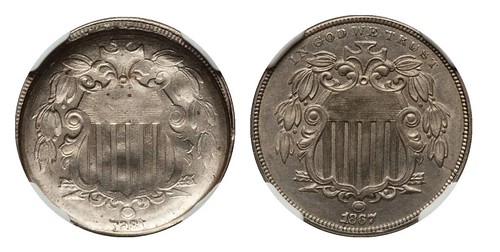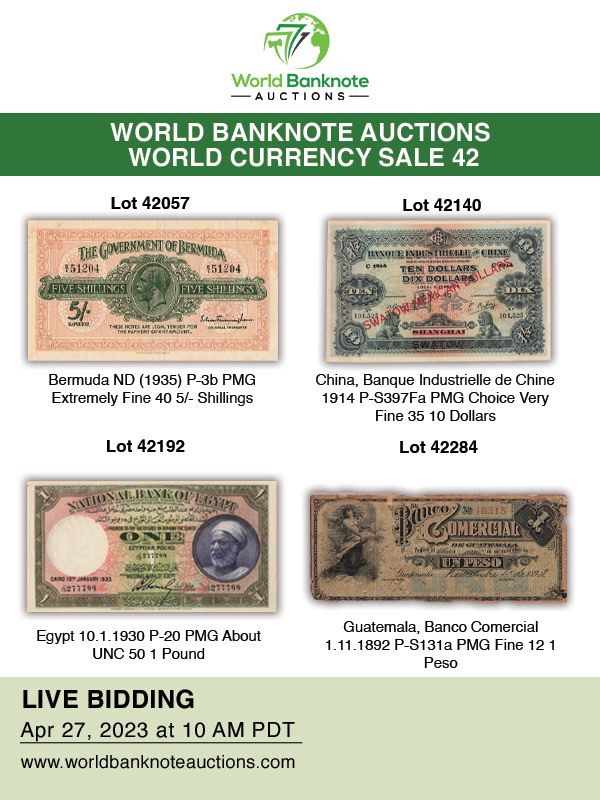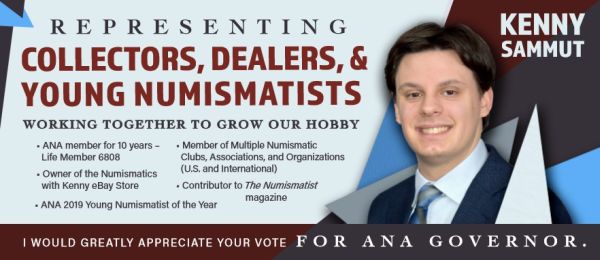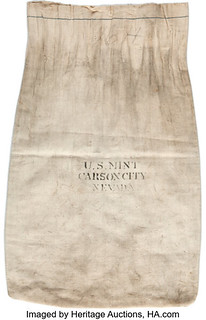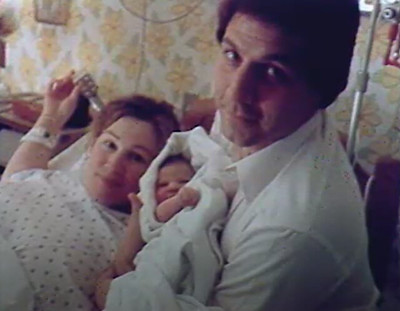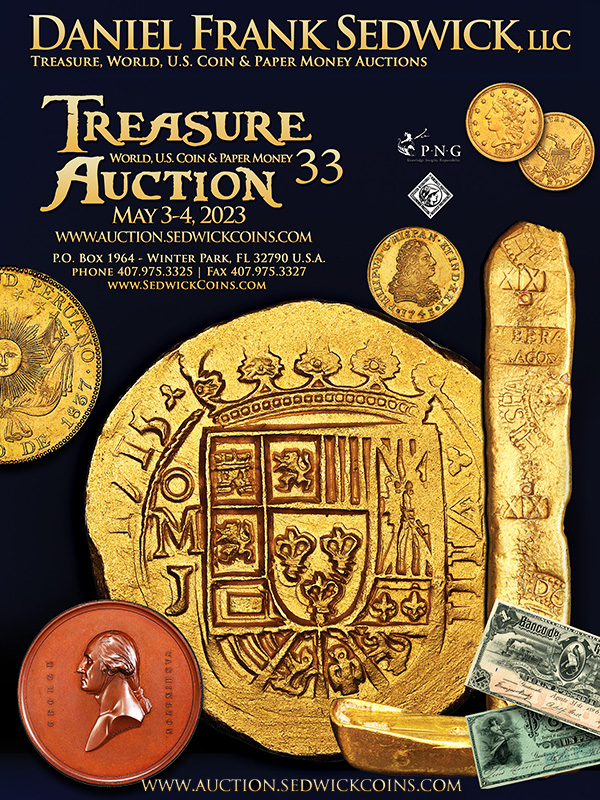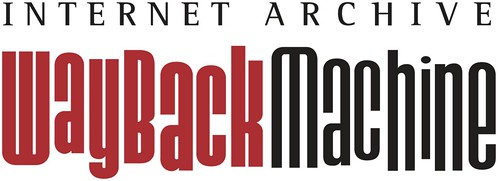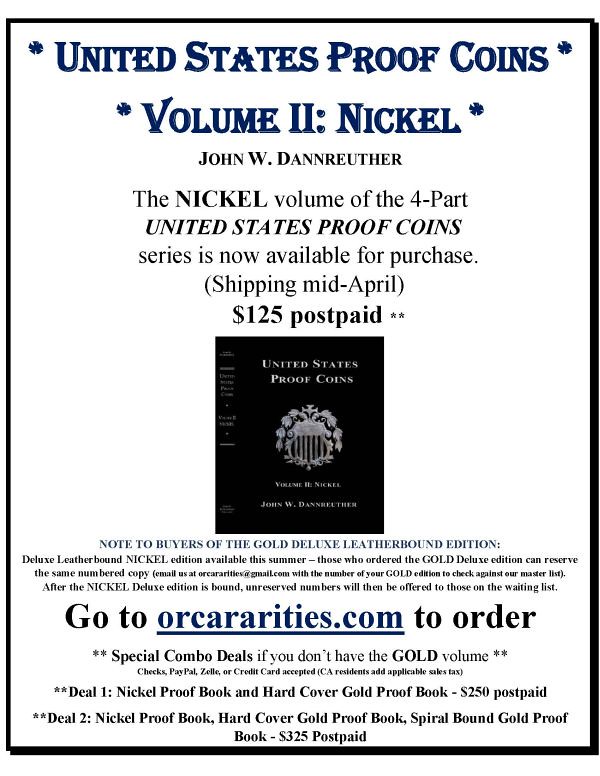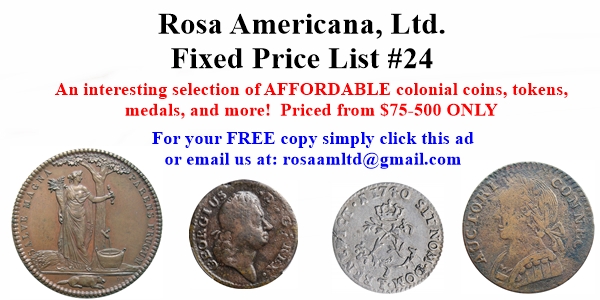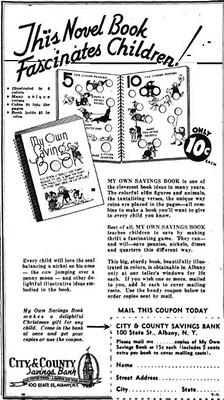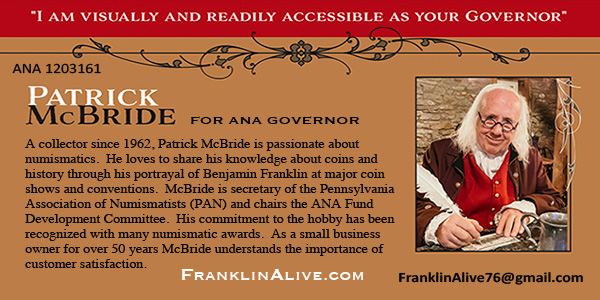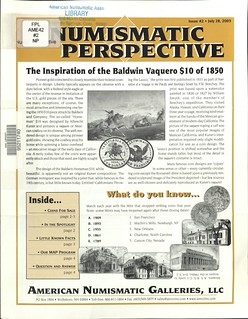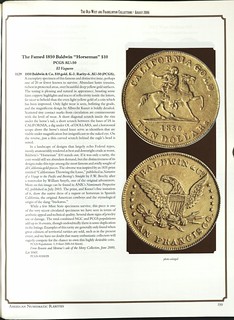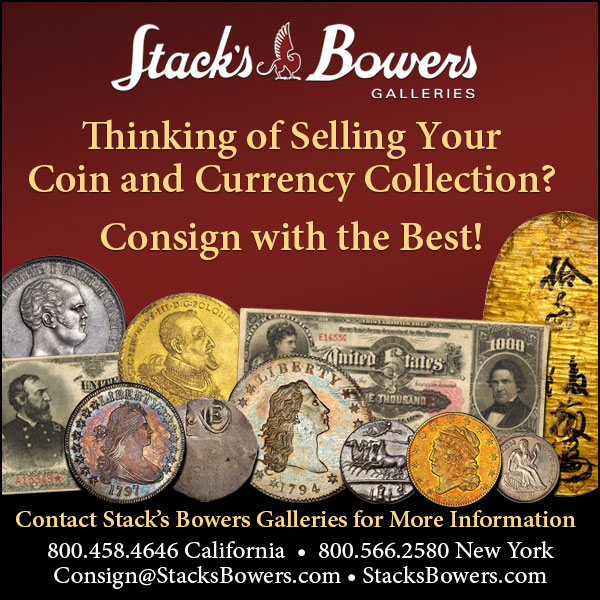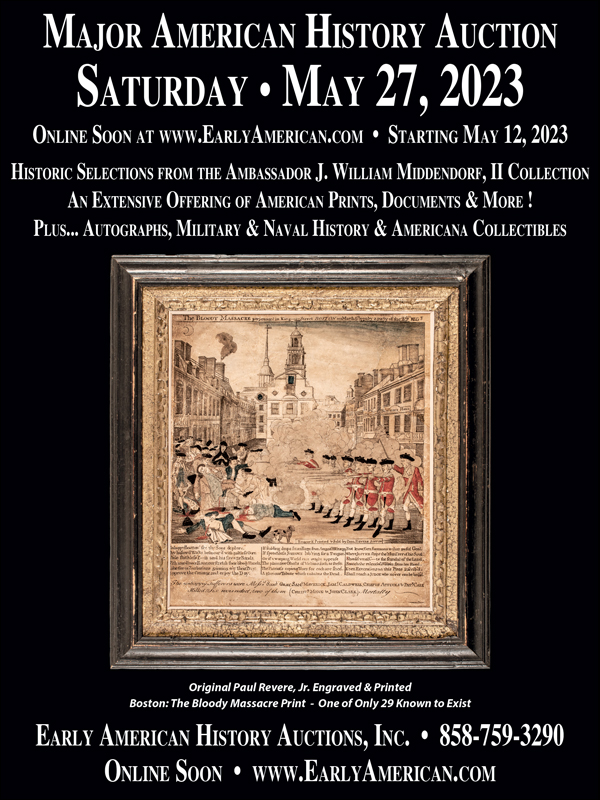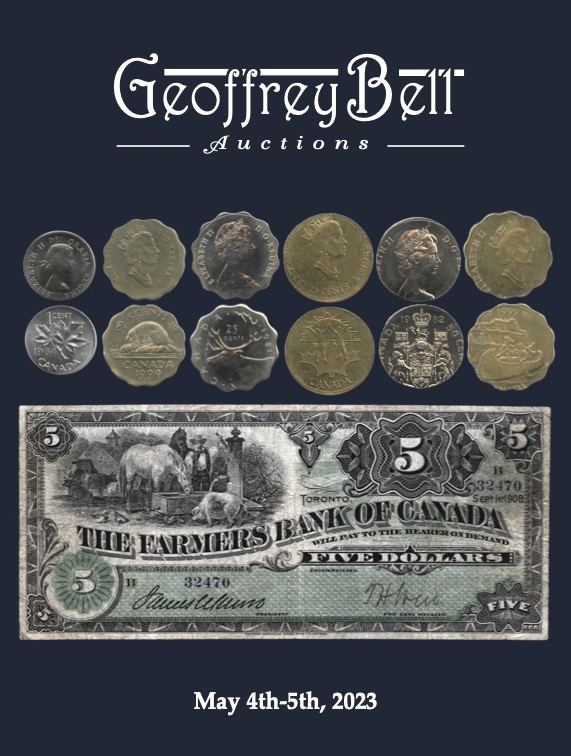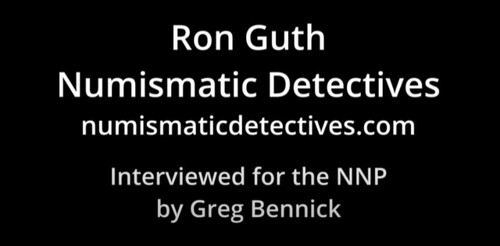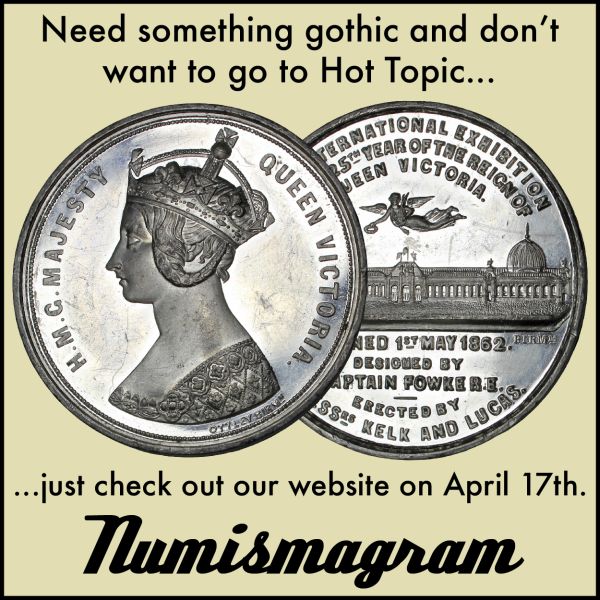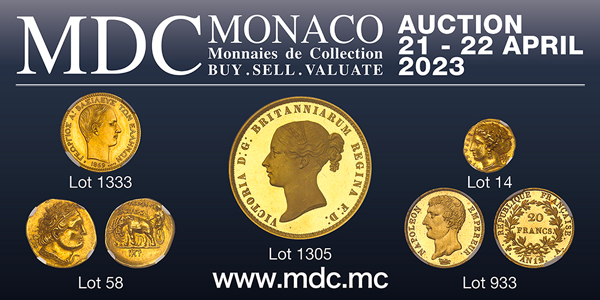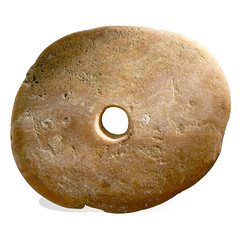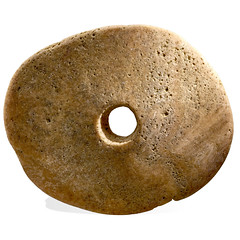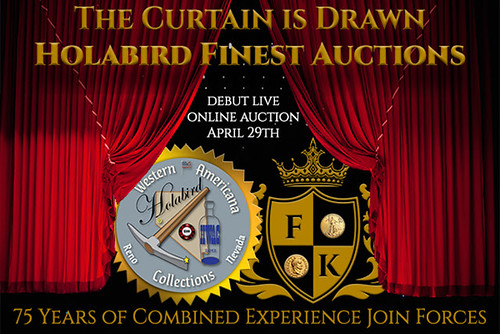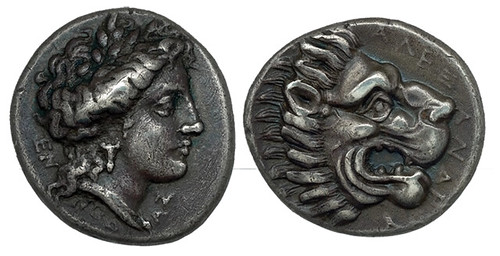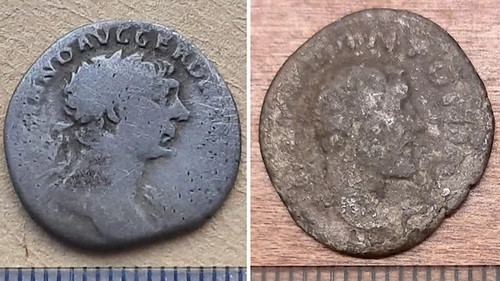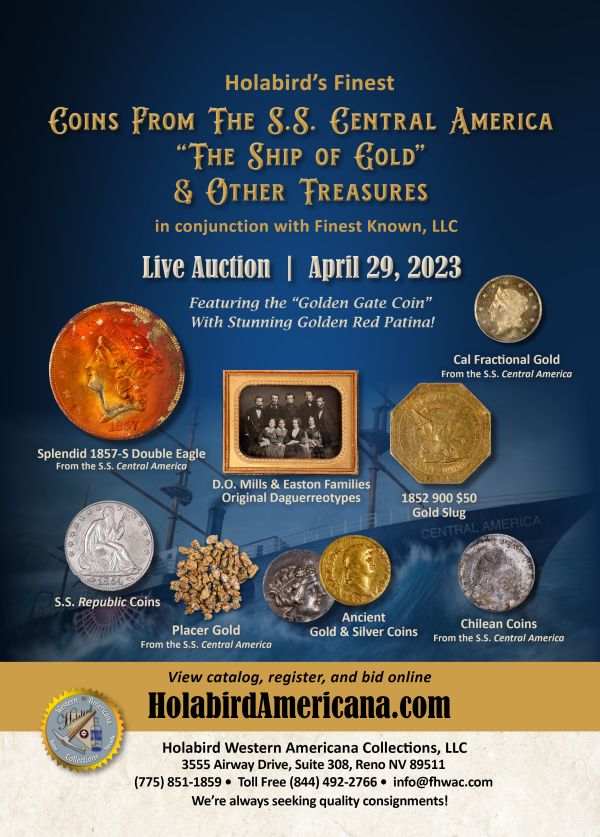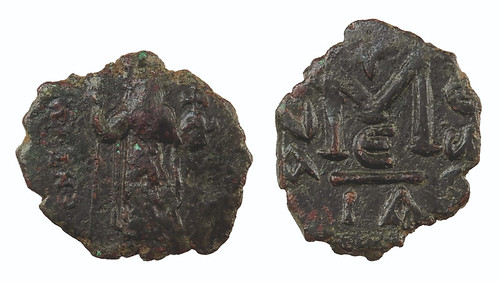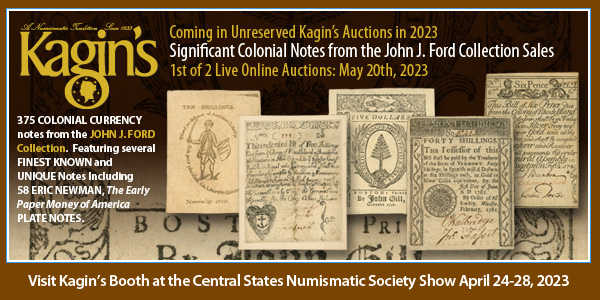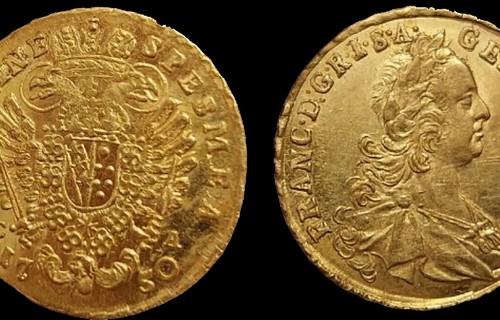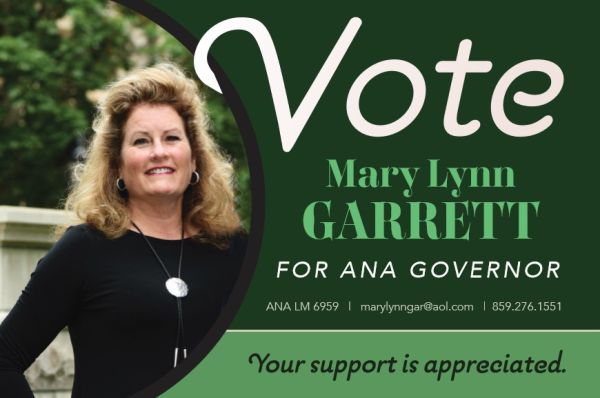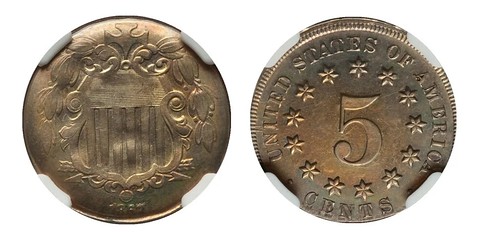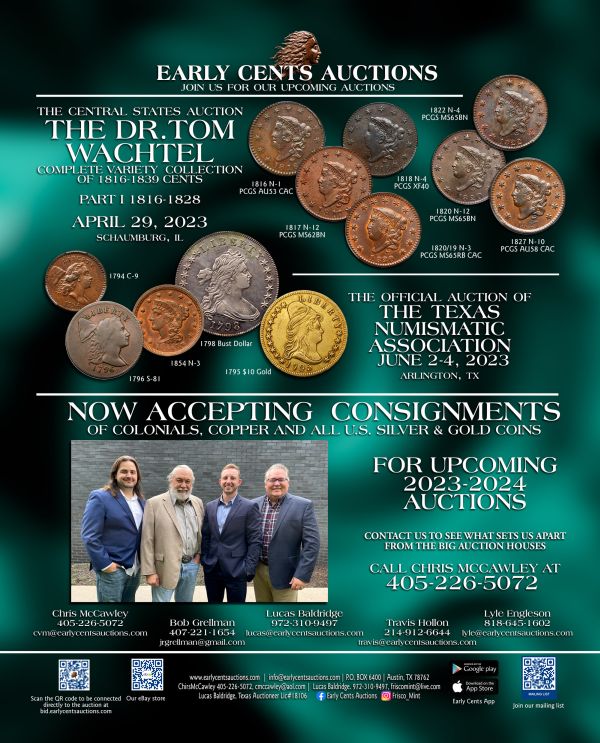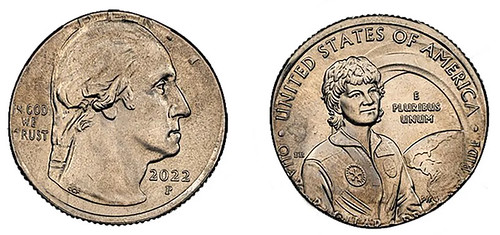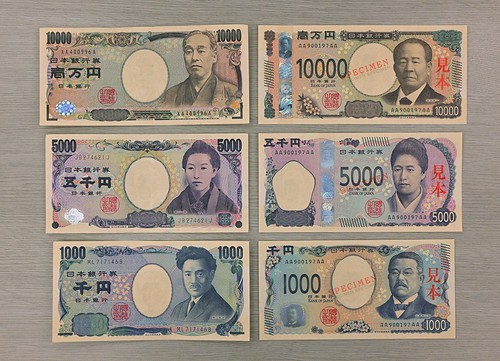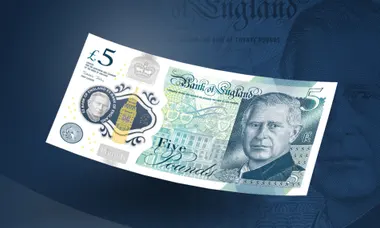
Visit our NBS Sponsors




About UsThe Numismatic Bibliomania Society is a non-profit association devoted to the study and enjoyment of numismatic literature. For more information please see our web site at coinbooks.org SubscriptionsThose wishing to become new E-Sylum subscribers (or wishing to Unsubscribe) can go to the following web page link MembershipThere is a membership application available on the web site Membership Application To join, print the application and return it with your check to the address printed on the application. Print/Digital membership is $40 to addresses in the U.S., and $60 elsewhere. A digital-only membership is available for $25. For those without web access, write to: Charles Heck, Treasurer AsylumFor Asylum mailing address changes and other membership questions, contact Chuck at this email address: treasurer@coinbooks.org SubmissionsTo submit items for publication in The E-Sylum, write to the Editor at this address: whomren@gmail.com BUY THE BOOK BEFORE THE COINSale CalendarWatch here for updates! |
- WAYNE'S WORDS: THE E-SYLUM APRIL 16, 2023
- NBS 2023 CHARITY AUCTION DONATIONS SOUGHT
- NEW BOOK: NOTGELD: GERMAN SERIES
- DELUXE EDITION OF SALYARDS' DOLLAR BOOK
- BOOK REVIEW: IMPERIAL DESIGNS
- NEWMAN PORTAL ADDS COIN BAG JOURNAL
- VIDEO: DAVID LISOT BECOMES A FATHER
- NEWMAN NUMISMATIC PORTAL WEBSITE ARCHIVE
- MORE ON HOWARD A. DANIEL III
- MORE ON THE MY OWN SAVINGS BOOK
- NOTES FROM E-SYLUM READERS: APRIL 16, 2023
- THE INSPIRATION FOR THE BALDWIN VAQUERO $10
- VOCABULARY TERM: MODULATED RELIEF
- CHARLES WYLLYS BETTS – THE FIRST 20 YEARS
- RON GUTH INTERVIEW, PART TWO
- PCGS 2023 SUMMER SEMINAR SCHOLARSHIPS
- 2023 NATIONAL COIN WEEK LECTURES
- BONHAM'S OFFERS LARGE YAP STONE DISC
- HOLABIRD AND FINEST KNOWN HOLD TREASURE SALE
- A SILVER DRACHM'S 150 YEAR PROVENANCE
- ROMAN COINS FOUND ON SWEDISH ISLAND
- ROMAN COIN FOUND AT BULGARIAN FORTRESS
- ANGLO-SAXON HOARD COIN STING
- 18TH CENTURY GOLD COINS FOUND IN POLAND
- ERROR SHIELD NICKEL MATED PAIR DISCOVERED
- SALLY RIDE QUARTER STRUCK ON NICKEL PLANCHET
- JAPAN UNVEILS NEW BANKNOTE DESIGNS
- BANK OF KOREA REPLACES SCORCHED NOTES
- DE LA RUE'S FINANCIAL TROUBLES
- I TRIED TO PAY MY TAXES IN CASH
- NYT PROFILES HERITAGE AUCTIONS
- THE RISE AND FALL OF TOMMY THOMPSON
- LOOSE CHANGE: APRIL 16, 2023
- TWO MILLION DIMES STOLEN
Click here to read the thin version on the web
Click here to subscribe
Click here to access the complete archive
To comment or submit articles, reply to whomren@gmail.com
Content presented in The E-Sylum is not necessarily researched or independently fact-checked, and views expressed do not necessarily represent those of the Numismatic Bibliomania Society.
WAYNE'S WORDS: THE E-SYLUM APRIL 16, 2023
 New subscribers this week include:
Ryan Baum of Davis, CA.
Welcome aboard!
New subscribers this week include:
Ryan Baum of Davis, CA.
Welcome aboard!
Thank you for reading The E-Sylum. If you enjoy it, please send me the email addresses of friends you think may enjoy it as well and I'll send them a subscription. Contact me at whomren@gmail.com anytime regarding your subscription, or questions, comments or suggestions about our content.
This week we open with the NBS Charity Auction, one new book, a beautiful deluxe edition, one book review, updates from the Newman Numismatic Portal, and more.
Other topics this week include notgeld, David Lisot, Howard Daniel, the Baldwin Vaquero design, modulated relief, the ANA Summer Seminar and National Coin Week lectures, Yap stone money, auction previews, error coins, new banknote designs, and Heritage Auctions.
To learn more about Canada's Ships, Colonies, and Commerce tokens,
the Numismatic Wayback Machine, Henry Voigt, C. Wyllys Betts, Bruce Banner, Ron Guth, the Golden Gate
coin, a rare mated pair of errors, scorched banknotes, and the Case of the Stolen Dimes, read on. Have a great week, everyone!
Wayne Homren
Editor, The E-Sylum
NBS 2023 CHARITY AUCTION DONATIONS SOUGHT
The American Numismatic Association's annual World's Fair of Money convention is coming along in a few short months. Time to prepare for Numismatic Bibliomania Society events. Vice President Len Augsburger submitted this call for donations for our annual book sale. -Editor
NBS 2023 Charity Auction
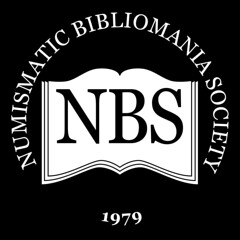 It's not too early to start planning for the NBS book sale at this year's ANA convention, and David Fanning has again graciously agreed to collect lots and catalog the sale. Literature donations may be sent to David at Kolbe & Fanning, 141 W. Johnstown Rd., Gahanna, OH 43230. Please contact David before sending material, so that he can ensure a stimulating mix of literature at varying price points.
It's not too early to start planning for the NBS book sale at this year's ANA convention, and David Fanning has again graciously agreed to collect lots and catalog the sale. Literature donations may be sent to David at Kolbe & Fanning, 141 W. Johnstown Rd., Gahanna, OH 43230. Please contact David before sending material, so that he can ensure a stimulating mix of literature at varying price points.
Donations should be received by June 30. This event always contains something of interest for just about everyone, and, thanks to the active participation of contributors and bidders, the proceeds typically cover a substantial portion of the club's operating expenses.
NEW BOOK: NOTGELD: GERMAN SERIES
Nathaniel Butler writes:
"I've been a loyal subscriber to the E-Sylum newsletter for many years, but this is the first time I've had something to contribute! I've just released my new book on the topic of German Notgeld. The title is Notgeld: German Series Notes, 1918 - 1922. This is the first book on the topic written primarily in English. Thank you so much for your continued service in providing the best numismatic newsletter in the known universe."
Congratulations on the new book! Here's the description. -Editor
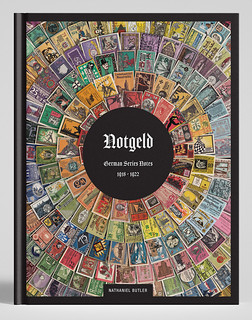 Notgeld: German Series Notes, 1918-1922 is the first catalog written primarily in English on the topic of German Serienscheine (Series Notes).
Notgeld: German Series Notes, 1918-1922 is the first catalog written primarily in English on the topic of German Serienscheine (Series Notes).
These Notgeld (German for Emergency Money
), many of which are now over 100 years old, would combine visually striking imagery with the rich local histories, folklore, historical figures, architecture, scenery, politics and humor to capture the attention of collectors throughout the world.
Building off of the indispensable work of German collectors and researchers like Dr. Arnold Keller, Kai Lindman, Manfred Mehl, Hans L. Grabowski, Reinhard Tieste, Manfred Müller and many others, this book aims to provide an updated resource for experienced and beginner collectors alike.
DELUXE EDITION OF SALYARDS' DOLLAR BOOK
Harry Salyards has produced a special deluxe edition of his new book on early silver dollars. -Editor
Eagle Poised on a Bank of Clouds: The United States Silver Dollars of 1795-1798
 The new Standard Work on the series. With historical background and contemporary context,
comprehensive discussion of each die marriage, enlarged high-resolution images of each die
state, the first attempt at a true Condition Census, and tips on putting together a decent collection
of these inherently expensive coins by focusing on nuances of strike, die wear, and variations in
depth of design hubbing from one variety to the next.
The new Standard Work on the series. With historical background and contemporary context,
comprehensive discussion of each die marriage, enlarged high-resolution images of each die
state, the first attempt at a true Condition Census, and tips on putting together a decent collection
of these inherently expensive coins by focusing on nuances of strike, die wear, and variations in
depth of design hubbing from one variety to the next.
Available in a sewn hardcover binding in blue cloth, with dust jacket, for $145 postpaid. Also produced in a limited edition of 10 copies hand-bound by the Harcourt Bindery, Boston, in green half morocco, marbled boards, spine decorated in gilt with five raised bands. Only five copies remain available, at $750 postpaid.
BOOK REVIEW: IMPERIAL DESIGNS
William Vanornum submitted this review of Christopher Faulkner's book, Imperial Designs: Canadian Ships, Colonies, and Commerce Tokens. Thank you! -Editor
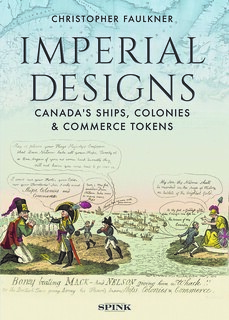 My Dad used to say that "comparisons are always odious." Good advice when talking about people in your life, but it's a maxim that doesn't apply to the numismatist. Comparisons hone and refine differences--especially tiny ones--between coins and their historical milieu. Some modern educational theories place "comparison" within the realm of higher thinking.
My Dad used to say that "comparisons are always odious." Good advice when talking about people in your life, but it's a maxim that doesn't apply to the numismatist. Comparisons hone and refine differences--especially tiny ones--between coins and their historical milieu. Some modern educational theories place "comparison" within the realm of higher thinking.
It can be especially fruitful to compare coins from different countries when there are many numismatic similarities.
The book "Imperial Designs: Canadian Ships, Colonies, and Commerce Tokens" by Christopher Faulkner is a 429+ page book published by Spink with precise and luscious design, two qualities rarely seen together in book-making. I find this important to note in a venue sponsored by the Numismatic Bibliomania Society. It opens a new vista into Canadian and United States numismatics as it brings into our careful focus the Breton 997 token--famous for its obverse of the sailing ship. I should say, "sailing shipS."
On the tokens I've first observed all the ships looked the same, and maybe they were, based on my limited sample of coins. But the ships differ! It may be how the flag is flying, a cut-know, the spiritsail or the foresail, or the looping of the hanging lines. (I will leave readers to look up and learn more about these terms.) In learning about these coins one also develops expertise about ships, and the author includes a neat table-line-drawing of the ships in miniature that helps the reader identify the coins. The ships were majestic. By the 1850s they were approaching 1,000 tons and by 1864 there was one launched that weighed over 33,000 tons.
NEWMAN PORTAL ADDS COIN BAG JOURNAL
The latest addition to the Newman Numismatic Portal is a new periodical. Project Coordinator Len Augsburger provided the following report. -Editor
The inaugural issue of the Journal of the Old Bag Collectors Club was published by Pete Smith on April 15. According to the Journal, the club is focused on coin storage bags imprinted with the name of the U.S. Mint, Federal Reserve, commercial banks, and coin dealers. Included in this issue is a notice of a rare Carson City bag appearing in an upcoming Heritage auction. The study of coin bags is a natural evolution for similar collector groups that have pursued coin boards, sample slabs, and related items for some time.
Image: Carson City bag, likely related to the GSA offering, from an upcoming Heritage Auctions offering.
THE BOOK BAZARRE
VIDEO: DAVID LISOT BECOMES A FATHER
The David Lisot Video Library on the Newman Numismatic Portal can be found at:
https://nnp.wustl.edu/library/multimediadetail/522852
We highlight one of his videos each week in The E-Sylum. Here's one from 1988 with a glimpse of David and his family. At about the 19:30 mark the Financial News Network hosts congratulate David and show photos of him with his wife Liz their newborn daughter Maxine. -Editor
NEWMAN NUMISMATIC PORTAL WEBSITE ARCHIVE
Newman Numismatic Portal Project Coordinator Len Augsburger provided the following report on NNP's web archive. -Editor
The Wayback Machine (http://web.archive.org/) is an archive of the World Wide Web, launched by Internet Archive in 1996. It allows users to go back in time and view old versions of web pages in addition to copies of web pages that no longer exist. It is by no means exhaustive, but, with a current size of 806 billion archived pages, it is unique and indispensable. Originally, the Wayback Machine was the only function of Internet Archive. Later, Internet Archive added scanning, digitization, and other services.
The power of the tool is immediately obvious. The media often reports on content that was removed from websites, and such verifications are made using the Wayback Machine. Related law is evolving, but Wayback Machine screenshots have been allowed as evidence in some courts. For sites that have been removed from the web, the Wayback Machine may represent the only copy that exists, and certainly the only one publicly accessible.
MORE ON HOWARD A. DANIEL III
Last week we announced the passing of researcher, author and good friend Howard A. Daniel III. Howard was a numismatic friend to all. Here's his published obituary, which has some additional information (and a new photo). -Editor
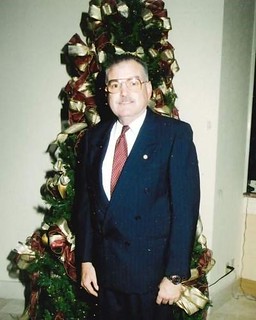 Howard A. Daniel III passed away at the age of 81 on April 5, 2023 after battling advanced melanoma cancer for 6 months. Howard was born in New York City and was the eldest of seven children produced by Howard A. Daniel, Jr. and Anita Lawler. He is survived by his wife of fifty years, Phung Daniel, and four younger siblings, his two sisters, Joan Ellis and Anne Moble, and two brothers, Michael Lawler and James Miolla.
Howard A. Daniel III passed away at the age of 81 on April 5, 2023 after battling advanced melanoma cancer for 6 months. Howard was born in New York City and was the eldest of seven children produced by Howard A. Daniel, Jr. and Anita Lawler. He is survived by his wife of fifty years, Phung Daniel, and four younger siblings, his two sisters, Joan Ellis and Anne Moble, and two brothers, Michael Lawler and James Miolla.
Howard served in the United States Army, enlisting in 1957 and retiring in 1981 achieving the rank of Master Sergeant. He was recalled to active duty in 1991 and retired in the same year in support of the Desert Storm campaign. Howard's service included assignments in France, Okinawa, Japan, Germany and Viet Nam where he met and married his wife.
MORE ON THE MY OWN SAVINGS BOOK
"My Own Savings Book came out in late 1939 and was widely advertised in 1940 and 1941. They stopped shortly after the war began, but I suspect it was a big seller as banks and other institutions sold them direct. Newspapers ran ads in 1947 and 1948, but then they stopped. I recall our local bank encouraging elementary school students to open bank accounts in the early 1950's. I did, but failed to keep up with it. Ten years later I opened a mutual fund and wish I had stuck with it. Live and learn. Try as I might, I was unable to come up with anything on Defend America Coin Savings Book."
NOTES FROM E-SYLUM READERS: APRIL 16, 2023
More on Henry Voigt
Bill Eckberg writes:
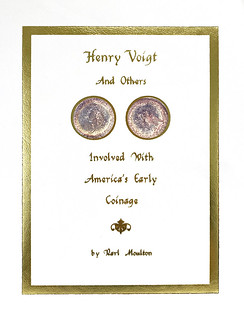 "I was curious to see that the deluxe edition of Karl Moulton's book, Henry Voigt and Others Involved with America's Early Coinage, published sixteen years ago, is finally available. I reviewed the strengths and weaknesses of the book in The E-Sylum when it came out, and there is no need to replow the ground of that review, which I stand by.
"I was curious to see that the deluxe edition of Karl Moulton's book, Henry Voigt and Others Involved with America's Early Coinage, published sixteen years ago, is finally available. I reviewed the strengths and weaknesses of the book in The E-Sylum when it came out, and there is no need to replow the ground of that review, which I stand by.
"However, substantial new information has come out since 2007 that is relevant. Voigt's contributions were greater than Moulton or I realized at the time. Elias Boudinot's report to the Third Congress in 1795, which I recommend reading, goes to great lengths to explain the herculean task that Voigt faced in setting up the works for the Mint and getting it operating. I particularly call the reader's attention to the following: "It was also a considerable time before an engraver could be engaged, during which, the chief coiner was obliged to make the dies for himself."
"What dies did he make? Everyone seems to agree now that Voigt made the dies for the 1793 half cents, Chain and Wreath cents. Some have claimed that Joseph Wright engraved the Liberty Cap cents of 1793, but there is no evidence that Wright ever worked at or was paid by the Mint for anything in 1793, nor did he request payment for anything in 1793. His estate was paid only for the dies for the 1792 Comitia Americana medal awarded to Henry Lee. Voigt also must have produced the Liberty Cap cent dies. All of this has been published over the past several years, much in The Numismatist and more in Penny-Wise.
"In an article to be published later this month in Penny-Wise, I show by image analysis that the 1794 silver Flowing Hair designs are closely derived from Voigt's 1793 Liberty Cap design, so Voigt can truly be said to be responsible for all of the designs of 1794 as well, with the exception of the half cent. I had for so long assumed that the designs for the silver coins were completely separate from those for the copper coins (they do look different, superficially, after all, and all later designs were, indeed separate) that I did not consider the possibility worth checking it out until I received an email from Jasper Burns, who deserves credit for first suggesting this.
"Voigt's contributions to the early US Mint and its coinage are even greater than Moulton's book claims. It is truly regrettable that no portrait of this man, who is in many ways the Founding Father of the Mint, is known to exist."
Thank you! -Editor
To read Elias Boudinot's report, see:
A Century of Lawmaking for a New Nation: U.S. Congressional Documents and Debates, 1774 - 1875
(https://memory.loc.gov/cgi-bin/ampage?collId=llsp&fileName=009/llsp009.db&Page=352)
To read the earlier E-Sylum articles, see:
REVIEW: HENRY VOIGT AND OTHERS INVOLVED WITH AMERICA'S EARLY COINAGE
(https://www.coinbooks.org/esylum_v10n49a06.html)
DELUXE EDITION OF MOULTON'S HENRY VOIGT BOOK
(https://www.coinbooks.org/v26/esylum_v26n15a02.html)
Other topics this week include Osborne Coinage and African Manillas. -Editor
THE INSPIRATION FOR THE BALDWIN VAQUERO $10
Cary Bown has some questions for our readers on the Baldwin Vaquero $10 of 1850. Can anyone help? -Editor
In the Issue #2 July 2003 of the fixed price list Numismatic Perspective issued by American Numismatic Galleries, LLC, the lead article, titled The Inspiration of the Baldwin Vaquero $10 of 1850
, the author (at the time of publication, Q. David Bowers was associated with American Numismatic Galleries, LLC) asserts that the inspiration for Albert Kuner's design of the coin's obverse originated from a print titled "Californians Throwing the Lasso" credited to Wm. Smyth, which was first contained in F.W. Beechey's book Narrative of a Voyage to the Pacific and Beering's Strait to Cooperate with the Polar Expeditions... published in 1831 by Colburn and Bentley in London. In this article, the author states that the print "while famous in the 19th century, is but little known today".
VOCABULARY TERM: MODULATED RELIEF
Here's another entry from Dick Johnson's Encyclopedia of Coin and Medal Terminology. -Editor
Modulated Relief. The rise and fall of three-dimension sculptural surface; the total surface planes and curvatures forming a coin or medal design. Modulated relief is created during the step of modeling a design. It is formed by adding material, or carving it away, the function of modeling. The purpose of the model – irrespective of its media, clay, wax, plaster, wood, whatever, or its size – is to convey a surface to a manufacturer who will render this surface, usually by reduction, into a die or mold which to reproduce the coin or medal.
CHARLES WYLLYS BETTS – THE FIRST 20 YEARS
E-Sylum Feature Writer and American Numismatic Biographies author Pete Smith submitted this article on C. Wyllys Betts. Thanks! Pictured below are Betts and the die for the Novum Belgium piece (with its lettering and images in reverse). -Editor
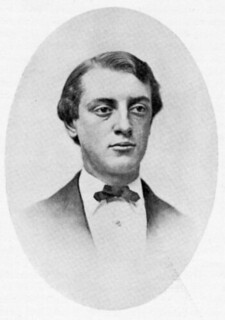 Don't believe everything you may read about C. Wyllys Betts. In the June 2000 issue of The Numismatist,
an inexperienced researcher wrote this about Betts.
Don't believe everything you may read about C. Wyllys Betts. In the June 2000 issue of The Numismatist,
an inexperienced researcher wrote this about Betts. The two-faced Janus might be a good choice to
represent Charles Wyllys Betts who began his numismatic career as a scoundrel and ended as a scholar.
Today a more experienced researcher might be more forgiving of his youthful indiscretions.
Charles Wyllys Betts was born at Newburg on the Hudson, New York, on August 13, 1845. His father was Judge Frederick Joel Betts (1802-1879). His mother was Mary Ward Scoville (1812-1868). Judge Betts moved the family to New Haven, Connecticut, in 1855 so his sons could be educated at Yale.
RON GUTH INTERVIEW, PART TWO
Greg Bennick's latest interview for the Newman Numismatic Portal is with author, researcher and Numismatic Detective Ron Guth. Here's the second part, where Ron talks about becoming a numismatic writer and researcher. -Editor
Greg Bennick: Very cool. So how did you start down the path of being a researcher and a writer? How did that come about?
Ron Guth: I guess it came about when I started the auction company with Jeff Garrett in 1983 ish. Then, of course I became a cataloger and a photographer. Back then, there was no digital photography. So I actually took a course at Transylvania University to the really odd name in Lexington, Kentucky and I learned how to do photography. And I actually did the processing in our bathtub at home, which of course drove my wife crazy because I had pictures of coins all over the bathroom, but that's what you did. So I became a writer and then years later, I went to California, which is where I am now and I started working with Dana Linett at Early American History auctions. I started out as a numismatic cataloger for him, but then I got into historical documents, so basically, I became a writer. You know, people can describe things as basically just looking at a coin and saying what are the positives or the negatives? Of course, you try to play at the positives, but it's basically just putting into words what you see with your eyes.
PCGS 2023 SUMMER SEMINAR SCHOLARSHIPS
PCGS announced two scholarships to the ANA's upcoming Summer Seminar. Here's the announcement. -Editor
The Professional Numismatists Guild (www.PNGdealers.org) is giving two scholarships this year instead of one so that two young numismatists can attend the American Numismatic Association's 2023 Summer Seminar in Colorado Springs, Colorado.
In recognition of the recent passing of long-time PNG member John N. Rowe III,
another member-dealer who wants to remain anonymous has graciously funded a
scholarship in John's name. So, we are awarding ANA Summer Seminar scholarships
to two YNs this year,
explained PNG Executive Director Robert Brueggeman.
2023 NATIONAL COIN WEEK LECTURES
The American Numismatic Association is hosting a series of online lectures this week to celebrate National Coin Week. -Editor
National Coin Week was established to encourage the enjoyable hobby of coin collecting through fun activities, contests, quizzes, educational content and more. This year's 100th annual event will take place April 16-22 and feature free, live educational webinars focused on the theme "Our Money, Our Heritage, Our America." All courses start at 5 p.m. MT.
BONHAM'S OFFERS LARGE YAP STONE DISC
Paul Song of Bonham's Los Angeles alerted me to this Yap Stone Disc with a great provenance in their April 27 new York auction. Thanks. Great display piece for any numismatic office, museum or library. -Editor
Extremely Rare and Large Currency Disc, Yap Islands, Caroline Islands
rai
Stone (probably calcite)
Diameter (widest) 26in (66cm)
Provenance
Dr. John Henry Felix, Honolulu, presented to him by the Yap government for his more than thirty years of service in Micronesia as Head of the Red Cross
American Private Collection
Exhibited
Red Cross Headquarters, Honolulu, Hawai'i
HOLABIRD AND FINEST KNOWN HOLD TREASURE SALE
Holabird Western Americana and Finest Known LLC are holding a joint treasure auction this month - here's an excerpt from the press release. -Editor
Two great companies are joining forces, using their combined 75 years of exceptional experience to present to you an auction of some of the Finest Known Treasure and Numismatic rarities!
This one-day special auction presents an excellent sample of rarities in various treasure classes: SS Central America; SS Republic; Private Territorial
gold coins; treasured Morgan dollars; ancient coins and more.
Both of our companies specialize in treasures. Everyone is fascinated by treasure – whether it is a gold coin found in your own backyard; in a clay pot full of mint state ancient coins; artifacts and coins from the ocean floor, or in a long-held private collection. It's all treasure!
A SILVER DRACHM'S 150 YEAR PROVENANCE
A CoinWeek article by Tyler Rossi explores the 150 year unbroken provenance of a silver drachm of Alexander of Pherae. Here's an excerpt - see the complete article online. -Editor
Alexander oversaw a massive minting program that included a series of beautiful silver drachmai. This particular drachm stuck by Alexander (shown below) is a stunning example of classical Greek numismatic artistry.
Pherai, Alexander tyrant. c. 369-358 BCE. AR Drachm, 5.87g (18mm, 10h). E? – ???? – ?S Laureate head of Ennodia r., wearing pendant earring and pearl necklace / ???? – ???? – ?? Lion's head r., with open jaws. Image: Shanna Schmidt Numismatics. Image: CNG.
ROMAN COINS FOUND ON SWEDISH ISLAND
Here's an article about the discovery of a couple Roman coins on a Swedish island. Found via The Explorator newsletter. To subscribe to Explorator, send a blank email message to: explorator+subscribe@groups.io. -Editor
Archaeologists found 2,000-year-old Roman coins on the Swedish deserted island of Gotska Sandön.
Previously, ancient Roman coins were discovered on the Swedish island of Gotland. Finding similar ancient items on the deserted island of Gotska Sandön, on the other hand, is unusual. Because of its location, it is a unique discovery.
ROMAN COIN FOUND AT BULGARIAN FORTRESS
A late Roman coin has been found at a fortress in Northern Bulgaria. -Editor
A Late Roman coin was discovered at the fortress Kale Shirokovo in Ruse, Deyan Dragoev, curator in the Archaeology department at the Ruse Regional Historical Museum told BTA.
The coin was from the period of Roman emperor Constans II. It was minted in 651 AD and is made of bronze. It is one of the latest ancient coins discovered in monern Northern Bulgaria during archaeological research, explained Dragoev.
ANGLO-SAXON HOARD COIN STING
Undercover police recovered rare coins from a Viking hoard. -Editor
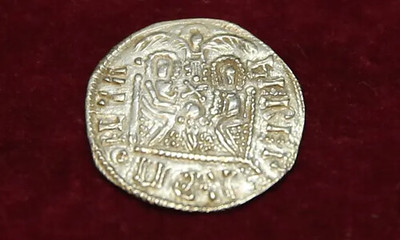 Two amateur history enthusiasts have been accused of trying to sell ancient coins from a Viking hoard to representatives of a mystery American buyer who were in fact undercover police officers.
Two amateur history enthusiasts have been accused of trying to sell ancient coins from a Viking hoard to representatives of a mystery American buyer who were in fact undercover police officers.
Roger Pilling, 74, of Rossendale, Lancashire, and Craig Best, 46, of Bishop Auckland, County Durham, are facing a jury trial at Durham crown court.
18TH CENTURY GOLD COINS FOUND IN POLAND
Some 18th century gold coins have been found in Wroclaw, Poland. -Editor
ARCHAEOLOGISTS EXCAVATING IN THE POLISH CITY OF WROCLAW HAVE DISCOVERED GOLD COINS DATING FROM THE 18TH CENTURY.
The discovery was made in the historical Przedmiescie Mikolajskie district, located west of the medieval city centre. During the 12th and 13th century, this part of the city was the former location of the villages of Nabitin and Stapin.
ERROR SHIELD NICKEL MATED PAIR DISCOVERED
Len Augsburger passed along Ken Potter's Numismatic News article about Greg Bennick's discovery of a rare mated pair of error Shield Nickels. Congratulations! Here's an excerpt - see the complete article online. -Editor
Numismatic News reader Greg Bennick has discovered a mated pair of uncirculated 1867 Shield nickels under-described in auction as a lesser error type. The error pair includes planchets intended for both a copper-nickel alloy 3-cent and a Shield nickel 5-cent piece, but neither the original grading service nor auction house mentioned that a 3-cent planchet was involved. This error combination involving the planchets of two different denominations elevated the coin to a far rarer error type than if it was a mated pair of like planchets. Mated pairs are rare on United States coinage but nowhere near that of this multi-denominational mated pair.
Even more unusual – not only were the two pieces struck together, but the 3-cent piece had been struck previously by Shield nickel dies rather than 3-cent dies! Upon entering the press a second time, it landed on top of a Shield nickel planchet and was struck again, imparting a Full Mirror Brockage into the Shield nickel from the first strike. The coin virtually covered the 5-cent planchet on the second strike. The difference was so slight that it was virtually undetectable, but it was enough that it almost completely hid the fact that a smaller planchet was involved.
SALLY RIDE QUARTER STRUCK ON NICKEL PLANCHET
Another error coin featured in Numismatic News is this Sally Ride quarter struck on a nickel planchet. Interesting modern error. -Editor
A 2022 Sally Ride American Women quarter that was mistakenly struck on a Jefferson nickel planchet has been certified by Numismatic Guaranty Company (NGC). Graded Mint Error MS-67, it is being offered by GreatCollections on April 30.
Wrong planchet errors are dramatic because they often involve the truncation of a coin's design. The smaller nickel planchet affected the words LIBERTY
on the obverse as well as QUARTER DOLLAR
and DR. SALLY RIDE
on the reverse.
THE BOOK BAZARRE
JAPAN UNVEILS NEW BANKNOTE DESIGNS
The Bank of Japan unveiled new banknote designs this week. -Editor
The Bank of Japan unveiled samples of new high-security banknotes that it will start issuing around the first half of fiscal 2024 to the media on April 14.
The new notes went on display at the Currency Museum in Tokyo's Chuo Ward the same day, and will also be displayed at the Bank of Japan Otaru Museum in Japan's northernmost prefecture of Hokkaido from April 28.
BANK OF KOREA REPLACES SCORCHED NOTES
Most central banks offer a service to replace damaged banknotes the Bank of Korea recently replaced notes burned in a wildfire. -Editor
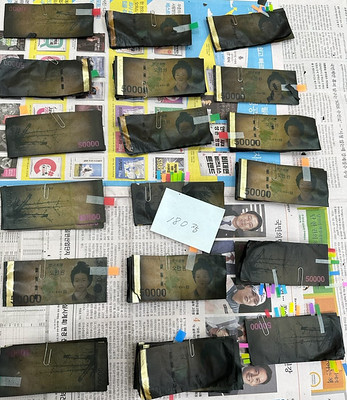 One hundred and eighty 50,000-won bills ($38.50) scorched by the Gangneung fire were replaced by the central bank.
One hundred and eighty 50,000-won bills ($38.50) scorched by the Gangneung fire were replaced by the central bank.
According to a local media outlet Thursday, the owner of a vacation house, which was burned by a wildfire that broke out in the coastal city in Gangwon on Tuesday, found a stack of charred 50,000-wons after the blaze was extinguished.
He took the 9 million won to the Bank of Korea's Gangneung office and requested an exchange.
A damaged banknote can be replaced if more than three-fourths of the note remains intact. If two-fifths of the note remains whole, half the amount of the bill is refunded.
Dented or rusty coins can be replaced with new ones, but not if their authenticity cannot be confirmed.
DE LA RUE'S FINANCIAL TROUBLES
Iconic banknote printer De La Rue is having financial troubles; their chairman has just resigned. -Editor
The chair of British banknote printer De La Rue has resigned after months of attempts to oust him and criticism of the company's leadership by one of its largest shareholders.
De La Rue, which can trace its history back more than 200 years, is responsible for printing about a third of all banknotes in circulation worldwide including the new Charles III design being produced for the Bank of England.
I TRIED TO PAY MY TAXES IN CASH
This note is legal tender for all debts public and private.
So can you pay your taxes with it? A Boston University professor
tried to find out. -Editor
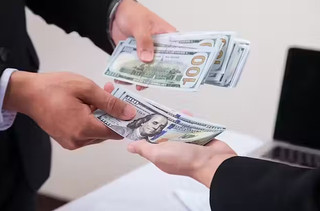 About two-thirds of all U.S. residents who file federal income taxes typically get a refund. Unfortunately, this year I am among the other third who owe the Internal Revenue Service money.
About two-thirds of all U.S. residents who file federal income taxes typically get a refund. Unfortunately, this year I am among the other third who owe the Internal Revenue Service money.
So I tried something I've never done before and few people do: I wanted to pay my tax bill in cash – that is, with real paper currency.
NYT PROFILES HERITAGE AUCTIONS
The New York Times had a nice profile of Heritage Auctions this week. Here's an excerpt - see the complete article online. Boom times at the nostalgia factory. -Editor
Objects with a bit of history have an obvious attraction in a high-tech world. The current cultural tumult, with its boom in fake images, endless arguments over everything and now the debut of imperious A.I. chatbots, increases the appeal of things that can't be plugged in.
At the same time, advances in technology mean it is ever easier to buy expensive things online. Bids at auctions routinely reach tens, even hundreds, of thousands of dollars.
THE RISE AND FALL OF TOMMY THOMPSON
National Geographic and BBC Studios are planning a documentary series on S.S. Central America explorer Tommy Thompson. -Editor
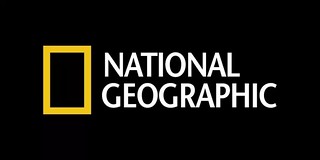 National Geographic and BBC Studios' Documentary Unit announced the greenlight of LOST GOLD, a three-part limited series that traces the rise and fall of maverick scientist and explorer Tommy Thompson — from his life-changing discovery of the wreck of the S.S. Central America to the turmoil that led to his prison sentence.
National Geographic and BBC Studios' Documentary Unit announced the greenlight of LOST GOLD, a three-part limited series that traces the rise and fall of maverick scientist and explorer Tommy Thompson — from his life-changing discovery of the wreck of the S.S. Central America to the turmoil that led to his prison sentence.
In 1989, Tommy Thompson stunned the world by recovering three tons of gold and historically priceless artifacts. Despite this staggering achievement, Tommy would be caught in a maelstrom of litigation, deception and personal turmoil for the next three decades as he tried to hold onto his find. Facing serious allegations, accused of defrauding his 161 investors, he went from ship deck to courtroom to prison cell. How — and why — did Tommy's extraordinary success unravel?
LOOSE CHANGE: APRIL 16, 2023
Here are some additional items in the media this week that may be of interest. -Editor
Author David Hendin passed along this opinion piece from the Jerusalem Post about how coins recorded and preserved key concepts of the Jewish State. Thank you. -Editor
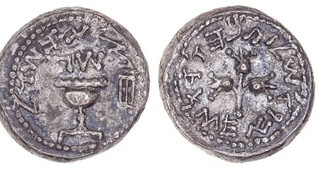 Brushing aside negative portrayals of the ancient rebels, the Zionists made an ideological connection to them because they had bequeathed an important legacy. During their brief independence (five years in the First Revolt and three in the Second Revolt), the rebels revived and repurposed key political concepts from the earlier periods of Jewish sovereignty, reinforcing these concepts and keeping their memory alive for a people about to enter a long period of forced exile.
Brushing aside negative portrayals of the ancient rebels, the Zionists made an ideological connection to them because they had bequeathed an important legacy. During their brief independence (five years in the First Revolt and three in the Second Revolt), the rebels revived and repurposed key political concepts from the earlier periods of Jewish sovereignty, reinforcing these concepts and keeping their memory alive for a people about to enter a long period of forced exile.
Among these concepts, all recorded on the rebel coins, are the name of the sovereign Jewish state (Israel), the title of a secular political leader (nasi
), the use of the Hebrew language to the exclusion of other languages, and even the goal of political independence (herut, freedom).
After the Romans quashed the revolts, Jews kept the coins. Finds occasionally surface in places like old Cairo. Maimonides and Nahmanides wrote about these Shekels of Israel,
the Renaissance rabbi Azariah dei Rossi studied them. Their ideas entered the Jewish cultural bloodstream, aided by a medieval Hebrew paraphrase of Josephus's work, called Sefer Josippon, which emphasized national resistance.
The Jewish rebels struck coins in silver and bronze, both to replace the Roman coins in circulation and to spread political messages. The inscriptions Shekel of Israel,
Jerusalem the Holy,
Shimon the Prince,
Year 2 of the Independence of Israel, Year 4 of the Redemption of Zion
are the equivalent of ancient tweets, real-time slogans from the revolts.
These ancient tweets are virtually the only surviving writing from the rebels.
Anyone who has been to Israel has seen the pictorial symbols on these revolt coins – national symbols like a palm tree and citron fruit or lulav and etrog, reminders of the Temple like its musical instruments and the high priest's staff. The modern State of Israel adopted them for today's coins.
To read the complete article, see:
The debt to the Jewish rebels against Rome - opinion
(https://www.jpost.com/opinion/article-739061)
To read earlier E-Sylum articles, see:
BOOK PREVIEW: GUIDE TO BIBLICAL COINS 6TH ED.
(https://www.coinbooks.org/v24/esylum_v24n47a04.html)
HALF-SHEKEL FROM THE GREAT REVOLT DISCOVERED
(https://www.coinbooks.org/v25/esylum_v25n51a23.html)
Other topics this week include the Cape Cod Area Philatelic Group, and the man who threw $100 bills out the car window. -Editor
TWO MILLION DIMES STOLEN
Speaking of Loose Change, Len Augsburger forwarded this article on the theft of two million dimes earlier this week. Thanks also to Paul Horner and Aaron Oppenheim for forwarding the story. -Editor
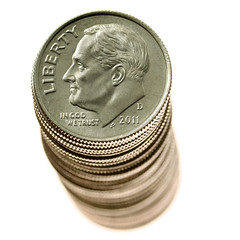 Police are investigating after someone broke into a trailer containing hundreds of thousands of dollars worth of dimes in Philadelphia.
Police are investigating after someone broke into a trailer containing hundreds of thousands of dollars worth of dimes in Philadelphia.
The discovery was made around 6 a.m. Thursday in a Walmart parking lot.
Police said an estimated two million dimes, worth $200,000, were stolen.
A total of $750,000 worth of dimes were in the truck, police said.
Dimes were found scattered from the parking lot to a nearby road.


